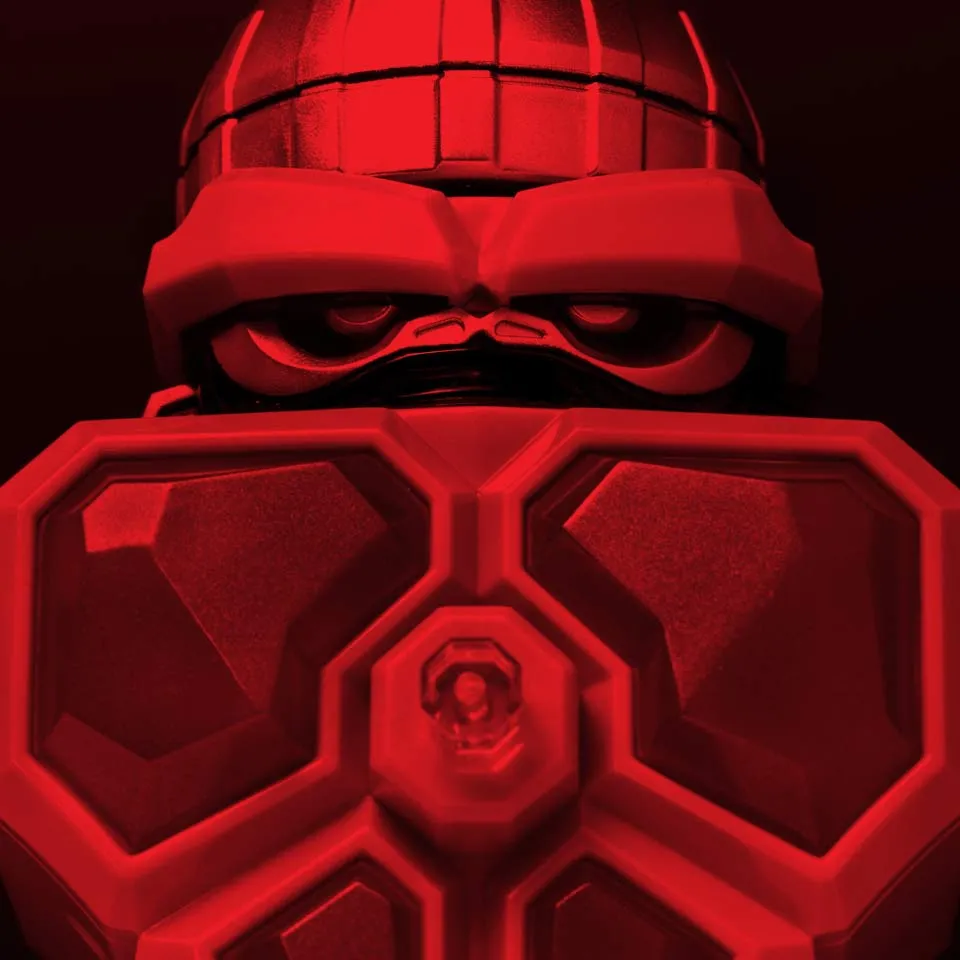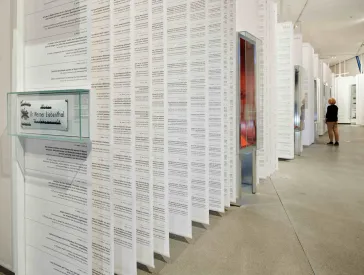Golem—Man Awakened with Glowing Hammer
Article in the Exhibition Catalogue GOLEM
Arno Pařík
In the course of the 1930s, a perceptible change came over what had previously been a rather carefree notion of the golem as a kind of artificial human. The influence of mounting social conflicts and the threat of fascism and war became apparent. In the work of Czech surrealists, phantom-like forms and figures or objects began to appear that were full of elaborate drama and veiled tension, evoking an embodiment of the human subconscious and all the irrational recesses of the human soul.
Among the outstanding works of the “youngest surrealist” František Hudeček (1909–1990) is Golem—Man Awakened with Glowing Hammer (1935–1937).1 A hallucinatory dream sequence, the picture shows a weary male figure—apparently wearing a diving suit, deep in the dark troughs of the ocean—being threatened by an eerie monster with clawlike arms reminiscent of an insect. The amorphous figuration reveals Hudeček’s technique of automatic painting, in which he used sheets of starch paper and distorting mirrors to transfer all sorts of deceptive shapes into the pictures.2 The awakening of the man by a blow to his head with a glowing hammer may be read as an analogy for the reanimation of the golem—by the Shem, the unspoken Hebrew name of God, or by means of a symbolic illumination that guides the way from the murkiest depths of the mind toward new knowledge. In this case, it probably refers most of all to the political situation of the time, and specifically the Spanish Civil War.
The figure of the golem was widely prevalent in the Czech context in the period. Hudeček may have encountered it in legends from Prague, in a 1930 production by the Liberated Theater, or in Julien Duvivier’s Franco-Czech film Le Golem (1936).3 Artistic treatments of the golem frequently feature fire. Similarly to the golem, it has a frightening destructive power, and it carries great significance for human beings as the vital ingredient in the alchemistic transmutation of metal and the forging of the world. Hudeček’s father was a village blacksmith, and the artist was fascinated by fire from his earliest childhood. In the dramatic year of 1938, he made a pastel drawing entitled My Father’s Smithy, in which the glowing forge, surrounded by streams of sparks and the figure of a sorcerer, becomes a focus connecting the world and the cosmos.4 The unconscious, destructive actions of the hammer-wielding giant in Golem, in turn, recall Hudeček’s painting The Wanderer—The Specter of the Civil War (1937).5
Arno Pařík is an art historian whose research interests include the history of Jewish Prague, the reconstruction of Jewish sites and synagogues, Jewish art in the nineteenth and twentieth centuries, and art from the Theresienstadt ghetto. He has curated many exhibitions at the Jewish Museum in Prague and written widely on Jewish memorials and artists.
Translated by Kate Sturge
- Regarding the first passage see: Jindřich Chalupecký, František Janoušek (Prague: Odeon, 1991), plates 74, 90, 123; Rudolf Kober and Gerd Lindner (eds.), Die zweite Arche: Der Surrealismus und die tschechische Kunst 1925 bis 1945 (Bad Frankenhausen: Panorama-Museum, 2001), 139. Here, see: Lenka Bydžovská,Vojtěch Lahoda, and Karel Srp, Černá slunce: Odvrácená strana modernity (Prague: Arbor Vitae, 2012), 220–221. ↩︎
- Eva Petrová and collective, Skupina 1942 (Prague: Atlantis, 1998), 30–32. ↩︎
- Arno Pařík, “Maharal and the Golem in Art,” in Path of Life: Rabbi Judah Loew ben Bezalel (ca. 1525–1609), ed. Alexandr Putík (Jewish Museum in Prague, 2009), 343–373; Arno Pařík, “Golem v českém umĕní aneb promĕny figurace,” in Golem v náboženství, vĕdĕ a umĕní (Jewish Museum in Prague, 2003), 87–105, plates 9–47. ↩︎
- Jiří Machalický and Martin Zeman, František Hudeček (Prague: Galerie Moderna, 2011), 74, plates 53 and 54. ↩︎
- Ibid., 64–65, plates 43 and 44. ↩︎
Golem—Man Awakened by Glowing Hammer František Hudeček, Prague, 1935–1937 Oil on canvas, 81 x 95 cm Photo: Galerie hlavního mesta Prahy
Citation recommendation:
Arno Pařík (2016), Golem—Man Awakened with Glowing Hammer. Article in the Exhibition Catalogue GOLEM.
URL: www.jmberlin.de/en/node/4707

Online Edition of the GOLEM Catalog: Table of Contents
The Golem in Berlin: Introduction by Peter Schäfer
Chapter 1
- The Golem Lives On: Introduction by Martina Lüdicke
- My Light is Your Life: Text by Anna Dorothea Ludewig
- Avatars: Text by Louisa Hall
- The Secret of the Cyborgs: Text by Caspar Battegay
Chapter 2
- Jewish Mysticism: Introduction by Emily D. Bilski
- Golem Magic: Text by Martina Lüdicke
- Golem, Language, Dada: Text by Emily D. Bilski
Chapter 3
- Transformation: Introduction by Emily D. Bilski
- Jana Sterbak’s Golem: Objects as Sensations: Text by Rita Kersting
- Crisálidas (Chrysalises): Text by Jorge Gil
- Rituals: Text by Christopher Lyon
- A Golem that Ended Well: Text by Emily D. Bilski
- On the Golem: Text by David Musgrave
- Louise Fishman’s Paint Golem: Text by Emily D. Bilski
Chapter 4
- Legendary Prague: Introduction by Martina Lüdicke
- Golem Variations: Text by Peter Schäfer
- Rabbi Loew’s Well-Deserved Bath: Text by Harold Gabriel Weisz Carrington
Chapter 5
- Horror and Magic: Introduction by Martina Lüdicke
- Golem and a Little Girl: Text by Helene Wecker
- The Golem with a Group of Children Dancing: Text by Karin Harrasser
- Bringing the Film Set To Life: Text by Anna-Carolin Augustin
- Golem and Mirjam: Text by Cathy S. Gelbin
Chapter 6
- Out of Control: Introduction by Emily D. Bilski
- Current page: Golem—Man Awakened with Glowing Hammer: Text by Arno Pařík
- Dangerous Symbols: Text by Charlotta Kotik
- Be Careful What You Wish For: Text by Marc Estrin
Chapter 7
- Doppelgänger: Introduction by Martina Lüdicke
- From the Golem-Talmud: Text by Joshua Cohen
- Kitaj’s Art Golem: Text by Tracy Bartley
- The Golem as Techno-Imagination?: Text by Cosima Wagner
See also
- GOLEM: 2016, online edition with selected texts of the exhibition catalog
- GOLEM: 2016, complete printed edition of the exhibition catalog, in German
- Golem. From Mysticism to Minecraft: Online Feature, 2016
- GOLEM: Exhibition, 23 Sep 2016 to 29 Jan 2017
